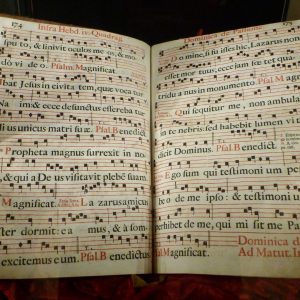
As a child, I never sang contemporary music in church. There was no such thing in those days. No, I’m more familiar with altars, candles, and organ music on Sunday mornings.
“Smells and bells,” describes those traditional church services where incense wafts through the sanctuary, and an acolyte rings a handbell at certain points in the day’s liturgy. Some teens today have probably never smelled incense (unless they were doing something they shouldn’t) and may wonder why you would need a hand bell in church anyway. While I can sing and shout with the best of them as we “make a joyful noise unto the Lord,” I fear we are losing part of the church’s precious heritage when the contemporary is the only music played in our worship services.
Out of the Dark Ages
As I write this, I am listening to medieval chants. Only occasionally used in liturgies today, plainsong (often called “Gregorian” chant) was dominant in Christian worship until the 12th century. Pope Gregory, who reigned from 590 to 604 AD, is credited with having either compiled the chants or with composing some of them.
Original chant is haunting, stark and reverent, lifting and soothing my spirit at the same time. I hear neither meter (regular beats) nor instruments; only a voice that gently follows a line of notes, or “neumes” that create a rising and falling lyrical path. The voice grows louder and softer as the musician intones the Psalm in Latin.
Chant is evocative and speaks to the soul as can no other musical form. I close my eyes and I’m in a gothic cathedral. Surrounded by marble and stone, I feel a draft, and can sniff the hint of sacred smoke. Cowled monks face each other at the foot of a marble altar and their solemn voices echo along the nave. A huge stained glass window above the altar sheds prisms of light that become shimmering mosaics on the stone floor. I feel like I can almost reach out and touch that blessed realm that surrounds us, where the cherubim and seraphim sing “Holy Holy” and continually glorify God.
The chant ends and now I hear another medieval composition. Here, another voice joins the first one, and they become like musical vines, each weaving its melodic tendril around the other. The polyphonic (many voices) song becomes thicker and richer as even more voices join in and meander to the final note. For me, this early medieval, sacred music is for my spirit what a rare fine wine is for my palate.
Enter the World
Trust me. Go to https://www.bing.com/videos/riverview/relatedvideo?&q=Gregorian+Chant+Listen+Online&&mid=AFBBBCA7DFB2A18CBB90AFBBBCA7DFB2A18CBB90&&FORM=VRDGAR
If you have never heard Gregorian chant or medieval polyphony in your life, you are about to step into a magical world of sound. And if you have heard chant, aren’t you glad you revisited it?
You’re welcome.


Gregorian Chant to me is like Yoga, soothing and heavenly. There are some contemporary stars that employ some of the chant’s characteristics, such as Pentonix singing “Mary Did You Know?”, which I gravitate towards. In addition there are some Celtic albums whose peaceful tones simply embrace me. Christmas is the perfect time to envision the darkened cloistered walls, flickering candles and silent cowled monks processing noiselessly as the hushed reverent tones echo in the holy places. Lovely!!!💝🌟
And that’s why the monks in “The Divine Meddler” process, chanting, into the chapel three times a day.
I agree the music we listened to when we attended Mass was sacred to many of us but then there was also respect for being in the house of God no cell phones, no butt cheeks hanging out of shorts that leave little to the imagination etc etc.It is difficult to feel reverent when surrounded by the world we live in today,
How true. Which may account for the world we live in today.